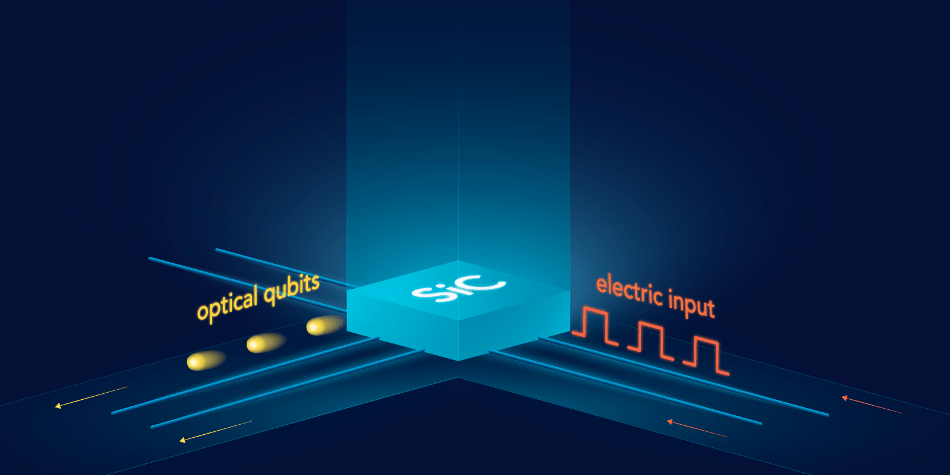Mar 22 2018
 Electrical excitation causes a point defect in the crystal lattice of silicon carbide to emit single photons, which are of use to quantum cryptography. (Credit: Elena Khavina, MIPT Press Office)
Electrical excitation causes a point defect in the crystal lattice of silicon carbide to emit single photons, which are of use to quantum cryptography. (Credit: Elena Khavina, MIPT Press Office)
Scientists at the Moscow Institute of Physics and Technology have “rediscovered” a material that could be the basis for ultrahigh-speed quantum Internet. In their paper published in the journal npj Quantum Information, they have demonstrated a strategy to increase the rate of data transfer in unconditionally secure quantum communication lines to over 1 Gbps, rendering the speed of quantum Internet comparable to its classical equivalent.
There is an ongoing race to realize quantum computing: Industry giants, such as Microsoft, IBM, and Google as well as universities and leading international research centers have contributed toward global attempts in developing a quantum computer. Although no one knows the exact timeframe in which this innovative technology could become a reality, the world is eagerly waiting. The foremost expectation on the quantum computer is its ability to crack the security of all classical data transfer networks. At present, encryption algorithms are used to protect sensitive data such as financial information or personal communication. A classical supercomputer will need many years to crack these algorithms. In contrast, it could take maybe only a few seconds for a quantum computer to do this.
Fortunately, quantum technologies are accompanied by a technology for neutralizing this threat. Since modern classical cryptographic algorithms are complexity-based, they can remain protected only for a limited period of time. In contrast to its classical equivalent, quantum cryptography is dependent on the basic laws of physics, which can ensure the security of data transmission forever. The operation concept is dependent on the aspect that an unfamiliar quantum state cannot be copied without modifying the original message. That is, it is hard to compromise a quantum communication line without the knowledge of the sender and the receiver. Even a quantum computer will not be useful for hackers.
The best carriers of quantum bits are photons, the quanta of light. It is most crucial to stress for the use of only single photons, or else one of the transmitted photons might be intercepted by a hacker, thereby obtaining a copy of the message. The concept of single-photon generation is very simple: An excited quantum system can liberate exactly one photon to relax into the ground state. From an engineering point of view, a real-world physical system with the ability to reliably produce single photons under ambient conditions is needed. Yet, it is not easy to find such a system. For instance, although quantum dots are a good option, they function well only upon being cooled below -200 °C, whereas new two-dimensional materials such as graphene cannot produce single-photons with a high repetition rate upon being electrically excited.
The MIPT scientists consider that silicon carbide, a semiconductor material that has been abandoned for a long time in optoelectronics, could be the solution.
In 2014, we were studying diamond and turned our attention to silicon carbide almost by accident. We figured it had vast potential.
Dmitry Fedyanin, Moscow Institute of Physics and Technology
Yet, as he described, an Australian research group achieved electrically activated emission of single photons in silicon carbide a year later, in 2015.
Astonishingly, the entire field of optoelectronics originated with silicon carbide as the basis: Electroluminescence, a phenomenon in which an electric current makes a material to emit light, was first observed in silicon carbide. In the 1920s, the first ever light-emitting diodes (LEDs) were developed by using this material. In the 1970s, the Soviet Union mass-produced the silicon carbide LEDs. Yet, following that, silicon carbide lost its sheen due to the direct-bandgap semiconductors and became long-forgotten in the field of optoelectronics. At present, silicon carbide is largely recognized as a heat-resistant and exceptionally hard material and is used in bulletproof vests, high-power electronics, and the brakes of sports cars produced by Ferrari, Lamborghini, and Porsche.
Teaming up with his associates, Fedyanin analyzed the physical aspects of electroluminescence of color centers in silicon carbide and proposed a theory of single-photon emission upon electrical activation that describes and promptly reproduces the experimental conclusions. A color center is a point defect in the silicon carbide’s lattice structure that absorbs or emits a photon at a specific wavelength to which the material is transparent if there are no defects. This process is most fundamental to the electrically activated single-photon source. The scientists have used their hypothesis to demonstrate the way a silicon carbide-based single-photon emitting diode can be enhanced to emit several billion photons per second. This is precisely the requirement for implementing quantum cryptography protocols at data transfer rates of the order of 1 Gbps. Igor Khramtsov and Andrey Vyshnevyy, co-authors of the paper, indicate that it is possible to find out innovative materials that can compete with silicon carbide with regard to the brightness of single-photon emission. Yet, in contrast to silicon carbide, they will mandate the use of innovative technological processes in the mass production of devices. On the other hand, single-photon sources developed from silicon carbide are compatible with the CMOS technology—a standard for fabricating electronic integrated circuits. This is why silicon carbide is, to date, the most favorable material for developing practical ultrawide-bandwidth unconditionally secure data communication lines.
The Russian Science Foundation (17-79-20421) supported this research.